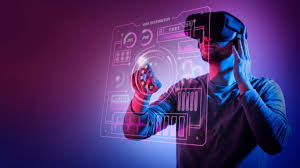Virtual Reality (VR) is no longer just a novelty—it’s rapidly becoming an essential part of industries from gaming and education to healthcare and enterprise. As hardware improves and development tools become more accessible, the next five years promise groundbreaking innovations in VR development. Here’s what the future holds.
1. Mass Adoption Driven by Standalone Headsets
The next wave of VR adoption will be powered by affordable, wireless VR headsets. Devices like the Meta Quest series, PlayStation VR2, and Apple Vision Pro are already reshaping the consumer market. Over the next five years, we’ll see a surge in lightweight, untethered headsets with higher resolutions and better battery life—removing the barriers that once limited VR access.
Developers will need to optimize apps for mobile processors and standalone hardware, making performance optimization a key focus in VR development.
2. Cross-Reality (XR) Becomes the Norm
The lines between VR, AR, and MR (Mixed Reality) are blurring. Future VR development will heavily incorporate extended reality (XR) features, enabling users to interact with both digital and physical environments seamlessly.
With platforms like Unity XR and WebXR, developers can create cross-platform experiences that run on VR headsets, AR glasses, and even mobile devices—maximizing reach and user engagement.
3. AI-Powered VR Experiences
Artificial Intelligence will play a significant role in shaping intelligent, responsive virtual environments. From dynamic NPCs (non-playable characters) in VR games to personalized learning modules in education, AI integration will make VR more interactive and adaptive.
Expect tools that use machine learning to automate gesture recognition, voice commands, and environment behavior, making development faster and smarter.
4. Enterprise & Training Applications Surge
The future of VR isn’t just entertainment. Enterprise VR development is growing fast in sectors like healthcare, manufacturing, and education. VR training simulations for surgeries, machinery operation, and soft skills will become standard in corporate environments.
For developers, this opens new career paths beyond gaming—building serious VR applications that solve real-world problems.
5. Social VR and the Rise of the Metaverse
While the “metaverse” may have lost some of its early hype, social VR is here to stay. Apps like VRChat, Meta Horizon Worlds, and Rec Room continue to gain traction. In the next five years, expect more realistic avatars, better voice and emotion tracking, and integrated commerce systems.
VR developers will focus on building social, persistent environments where users can work, play, and connect in immersive ways.
Conclusion: Developers Must Adapt to Stay Ahead
The future of Virtual Reality development is exciting and full of potential—but it also requires constant learning and adaptation. As the hardware improves and demand grows across industries, developers must stay on top of trends like AI integration, XR development, performance optimization, and multi-platform support.
Whether you’re an indie creator or part of a larger team, the next five years will be a defining era for how we build and experience virtual reality.













